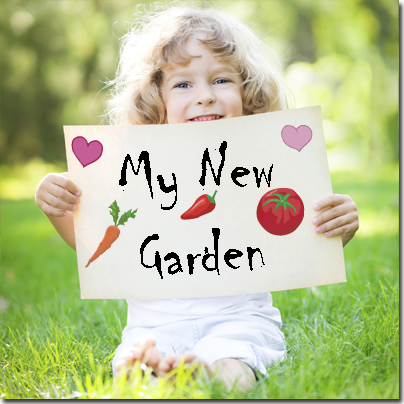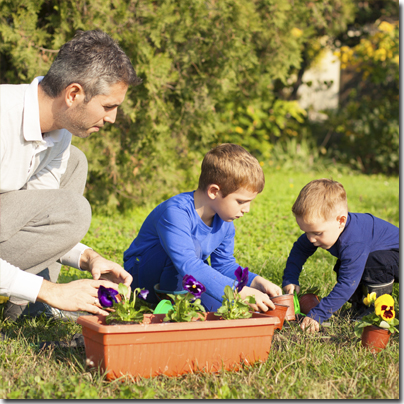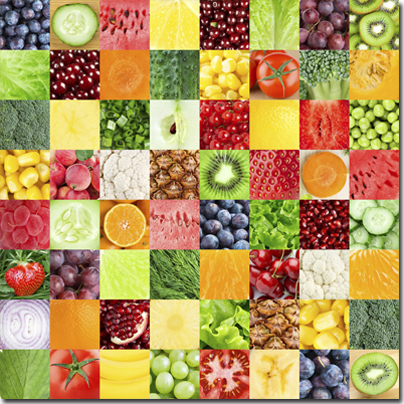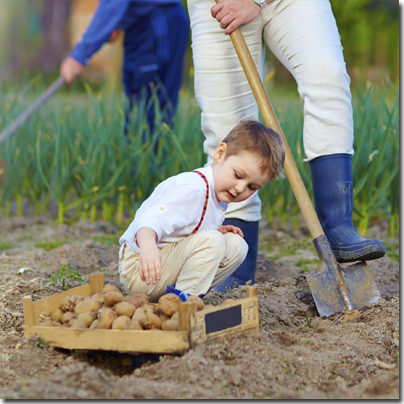 Vegetables and beans may not always be an adult’s first choice when deciding on a meal, let alone a child’s.
Vegetables and beans may not always be an adult’s first choice when deciding on a meal, let alone a child’s.
I found this to be true for my very own little and big ones. Using all my creativity, I investigated attractive ways I could encourage my own family to become enthusiastic healthy eaters.
My philosophy is that excitement, great taste and love around healthy food results in good health. Planting your own food in a kid-friendly garden can do wonders in achieving such a result.
With our busy schedules, such time-consuming undertakings ordinarily take the back seat and never reach completion. In many cases, they don’t even begin.
Being at home with our children during this time of social distancing, we now have the opportunity to create a kid-friendly garden and initiate this entertaining and enlightening practice.
There is more to learning than numbers and letters. Although these are important, let us use this time we have been given with our kids to teach them more than just academics.
Creating a vegetable patch where kids can grow and harvest their own vegetables teaches responsibility and a sense of accomplishment and instills appreciation for how the earth gives back to us through food.
This is also a chance where we can instill healthy eating habits while enjoying a new on-going activity. I learned this firsthand when I saw the delight on my daughter’s face, proudly showing me that the green beans she had planted with her teacher had begun to sprout.
Together we watered them daily, loved them immensely and watched them grow, as did her interest, as well as mine.
When the time arrived to pick the green beans, she helped to prepare them and not only ate her entire portion, but convinced her little brother to try them, too! He needed a little more persuasion. But persuaded he was. My pursuit of raising healthy eaters had begun.
Why was my picky eater so excited by these green beans?
Her amusement came from the enthusiasm and curiosity of growing them herself! All this resulted in the perfect outcome – consuming them not because she was being forced to do so, but because she herself desired to.
What’s more, growing them was a fun, educational activity we as a family enjoyed!
I believe this is something worth attempting with your own fussy eaters, with the hopes of encouraging them to experiment with new foods and hopefully build upon that. If this fundamental trial works, we could possibly move on to a full-blown love for vegetables. If not, at least a love for gardening vegetables.
It has been said that children need to be offered the same “new” food between 10-15 times before they actually decide to try it. From then, possibly another 10-15 times of trying for them to maybe like it.
Either way, I believe that children gardening is one step closer to raising healthy eaters in the future, even if the steps are at a snail’s pace.
Something positive will come from planting food in your own kid-friendly garden, even if not related to healthy eating at all. Anything good that comes of this is all that matters.
I hope that from my journey, you can be inspired to begin your own vegetable garden adventure with your children.
Here are some kid-friendly garden ideas to get you started. Let’s do this!
Step 1: Create a Space Where the Kid-friendly Garden Can Be Planted
 It need not be anything fancy to begin with and does not need to be large. A simple container (plastic, clay, stainless steel, cardboard – they all work) is a great place to start.
It need not be anything fancy to begin with and does not need to be large. A simple container (plastic, clay, stainless steel, cardboard – they all work) is a great place to start.
This part can be loads of fun! Decorate and make it your own. Paint your own container of choice, using a color of choice for each family member or each crop.
If you don’t feel like spending much time on decorating, that’s fine. There’s no need to rush to do this before you begin planting.
In fact, if you wait until after your seeds have been planted, decorating is a good way to keep busy while you wait for “something to happen,” since it may take a while. This will help keep the kids engaged and excited during the wait time.
If space is not an issue, clearing out a dedicated area in the garden allows for planting directly into the ground and a larger yield. We have a nice allocated area just for planting our crops, so we divided this into 3 rows (for myself, Miss Madame and Little Munchkin) in which we each planted four beans, one behind the other.
Each of us kept note of which row was whose by the way in which they were personally decorated. Actually, my daughter memorized everyone’s rows, while her brother was too small to be bothered.
Here’s what to do:
- Plant in an area that sees the sun for at least 6 hours a day if possible. The more sunlight, the better for the happiness of your veggies.
- Plant in a calm environment. This means a place that will not get flooded (proper drainage), blown too strongly by winds, or exposed to too much cold.
- Keep yourself calm, and be willing to get dirty as you start this process because things could (they most likely will!) get messy.
- Plant in loamy soil (soft and aerated). Your local gardening or home store should have all you need, as well as be able to advise you on what you actually need based on what you plan to grow and what you already have at home. You may not need to purchase much, or you may need to purchase everything.
Step 2: Buy the Necessities
 Now that you have your container, it’s time to buy your “necessities.”
Now that you have your container, it’s time to buy your “necessities.”
First, you’ll need to buy soil (if you have an existing garden, you may not want to buy soil, but it’s advisable because it’ll be richer in nutrients) and compost — enough to fill all the pots and/or your designated area.
You will want:
- Good topsoil, made up of silt, clay and sand, in a loamy mixture. Using soil from a local source is advisable. It is the best way to achieve success with your vegetable garden, as this soil has been formulated specifically for the local climate and environment.
- Good compost, necessary in providing adequate trace minerals and nutrients to your topsoil. Composted manures add quality amendments, also creating good soil texture for root growth. You can buy aged manure or green manure, or you can do your own composting, as I describe below.
The recommended amount of soil depends on the area in which you will be planting:
- If you’re planting in a small or average-sized pot, you’ll need an average of 10-20 cm depth.
- If you’re planting in the ground, you’ll need between 25-50cm depth. This depth would also be good for much larger or taller pots.
Purchasing a few garden tools, such as a spade, a garden fork and a watering can for each person, will be a pleasant added touch to bring upon the eagerness, but by no means is it mandatory.
In my experience, our “necessities” included colorful spades and forks for each of us, decorative crystals, colorful paint and ribbons. Yes, these are not the necessities I had in mind, but sure were my daughter’s!
If you have a shelter-in-place order within the area you are living and are unable to leave to get supplies, you can use soil from your existing garden. To add nutrients and minerals to this, add any organic waste matter. Please see step 3 below for some tips on how to do this.
Step 3: Compost the Easy & Lazy Way
 Have any old fruit or vegetable peels or flesh? Throw these leftover foods directly onto the soil around your seeds or plants. Coffee grounds are fantastic for your soil too.
Have any old fruit or vegetable peels or flesh? Throw these leftover foods directly onto the soil around your seeds or plants. Coffee grounds are fantastic for your soil too.
Children particularly enjoy being a part of this.
Every time we peel an apple or they have eaten a banana, they take the initiative to put this “waste” into our garden, rather than throwing it into a trash bin. This further adds minerals and nutrients to support the growth of your crops, as the food waste begins to decompose.
This is not thorough composting, hence the reference to “lazy,” and of course, you can get more fancy with your composting if you like, but we just throw our fruit and vegetable waste straight into our veggie patch and allow nature to do its thing.
Less hassle, more fun and a variety of nutrients for the ground. It works, even if it’s a little untidy.
Step 4: Prepare the Soil
 Now the real fun begins! It’s time to start getting a little messy…
Now the real fun begins! It’s time to start getting a little messy…
This is where children won’t hesitate to get involved. This is the one time they are asked to get dirty, and I am positive that they will enjoy playing while aerating the soil, with or without their tools.
I know my kids love playing with mud, so this was their time to shine. They got their bare feet and hands in there, really turning that soil. Kids will thoroughly enjoy mixing the soil.
If planting within existing soil in your garden, the soil should first be loosened (using a garden fork or spade).
It is advisable to add a thin layer of good quality top soil to your existing earthy ground, but not essential. This will allow your veggies to grow through the ground without too much effort. It will also create proper drainage so the water does not to collect on the top, but rather easily flows to the roots. This aerated soil will allow for enough oxygen to penetrate through the soil to the roots.
Once this is done, a layer of compost is the best way to complete the soil preparation.
As mentioned earlier, you’ll need enough topsoil to fill half the volume of your container, if you’re using one, (see above for advice on how deep to fill your container) and some compost to fill the other half of your planting space, for soil texture and food for the vegetables.
Once the soils have been mixed and placed in the pots or vegetable patch, rake the soil until level.
After loads of fun and entertainment — and let’s not forget, mess! — there we go, your soil is prepared.
Step 5: Get Your Seeds Ready
 Together with your child or children, choose and buy some seeds for your kid-friendly garden. What you buy will depend on what you want to grow.
Together with your child or children, choose and buy some seeds for your kid-friendly garden. What you buy will depend on what you want to grow.
It may be hard to choose from all the different seeds out there, but it’s not too challenging. I advise using organic seeds and starting with seeds which will sprout fairly quickly. With these, you will be able to see results quicker rather than later, keeping everyone’s attention.
We were lucky that we had started this process with beans from my daughter’s teacher. But as we got more into our gardening, we did eventually go to the store and had to go through the process of “choosing.”
Choosing with your children is important because it allows them to make the decision of what they are willing to try.
Tips: Based on quickest growing results and hardiness:
Green Beans
- Green beans sprout fairly quickly. In about a week, the plants will start to show through the ground! This is one of the quickest plants to see something actually happening.
- A few green beans will grow off each plant.
- If you plant 6-10 plants, you will be able to accumulate an adequate portion of beans that can be cooked immediately, or stored in the fridge until the second gathering, for even more yield.
- Once the beans have been picked, the same plant produces more beans. It keeps on giving, without having to replant.
- Also, if you allow one of the green beans to dry, the beans inside the pod can be removed and replanted directly into the ground for even more produce.
- The beans within the pod create a two-part healthy and fun food. My daughter enjoys the entire bean, whereas my son opens the green part and only eats the beans from within.
Spinach / Kale / Rocket (Arugula)
- Green leafy vegetables like spinach, kale and rocket (arugula) grow fairly quickly.
- Once these seeds have been planted and flourished, they can be cut off from the stem, and more leaves will regrow. No need to remove the entire plant (such as with root vegetables)
- With enough water and sun, a modest number of plants (also around 8-10) will supply you with enough leaves for a satisfactory edible family portion.
Tomatoes / Cucumbers
- These take a little longer to fruit, but they are definitely a bountiful plant to sow.
- Once the plant has grown, a stick or two will need to be placed in the ground so the stem can wrap around and grow even further.
- Once it is sturdy, it will flower. From those flowers, either the cucumbers or the tomatoes will grow.
- When they are ripe and large enough (tomatoes — red; cucumbers — green, solid), they can be handpicked and eaten as desired.
If you’re sheltering-in-place and going out is not an option, try using what you have at home. Don’t throw any seeds away from the fruits or vegetables you have eaten. Rather save them and air or sun dry them, to plant. Here are some tips:
- I find cucumber and tomato seeds easy to grow.
- Any dried beans you have at home can be planted directly into the soil.
Step 6: Planting & Germinating Seeds
Each child and parent can plant directly into the soil, in his or her own allocated area.
If planting into a “vegetable patch” in your garden, it’s a good idea to make your own harvest/veggie patch book to keep track of whose plant is whose and follow each of their growths and yields.
This will also add more attentiveness, allowing your kids to personally care for something of their own. If your kids are crafty, they might even have fun creating an elaborate book with drawings and decorations! Creating their own signs, either with written words or pictures and dates, helps in tracking each plant’s growth and type.
If planting into pots, plant one seed in each average-sized pot, allowing the roots and stems enough space to grow.
Personalizing each pot or marking either on the pot or in a book whose pot belongs to whom will eliminate any confusion. Painting or branding allows creative juices to flow, adding an art element, and will be extra fun!
Step 7: Learning Patience & Delayed Gratification
 Wait… Water… Observe…
Wait… Water… Observe…
And wait some more.
During this waiting, watering and observing period, make notes of what is happening. This is a good time to explain the process of photosynthesis and the importance of water, sun and soil in this natural process.
Love, caring and talking to your plants supports their growth. Call me crazy, but I talk to all my plants, with kindness and gratitude. It works and it’s fun, so just give it a try! The only thing you have to lose is your sanity.
Delayed gratification… (sigh)
We all too often want something and want it right now. Use this opportunity to help your kids learn and understand that sometimes (most times) good things are worth waiting for.
Waiting may not be fun, so we have a few tips to make this waiting process go a little smoother:
- Paint or decorate pots or add some color and fun to where the seeds in the ground are planted. If you use stones, wood or bricks to separate the different veggie areas and/or whose area is whose, paint those “separators” and create your own little magical, personalized space.
- It’s also a good idea to visit some organic, hydroponic farms or even greenhouses to show your kids what they have to look forward to with their own crops. For those of you sheltering-in-place this and this are a great places to start your YouTube vegetable garden exploration journey. Not only can it be a great way to show them the different ways of how veggies and plants can be successfully grown, but it’s a fun outing.
- Depending on the age of your kids, draw or print outlined pictures of plants growing, photosynthesis, vegetables, etc. Drawings of the different stages of the growth of plants or vegetables, including their roots (which we won’t be able to see), are a good way to show kids what’s simultaneously happening under the ground. These are perfect to color in and get a sense of what they can expect to grow.
Step 8: Pick and Enjoy
 When your vegetables are ready to be picked, demonstrate to your kids how to choose the ripest ones and the best way to remove them from the plant without damaging any parts.
When your vegetables are ready to be picked, demonstrate to your kids how to choose the ripest ones and the best way to remove them from the plant without damaging any parts.
Express your pride in your little ones’ triumphs, allowing them to feel pride within themselves for their dedication, patience and vegetable successes.
Display gratefulness towards the plant for what it has provided, and teach your children to show thankfulness to their plants — in the picking process as well as when cooking or eating, too.
When all has been harvested, your vegetables can be washed, prepped, stored or cooked — and enjoyed immediately or later. Here are some ideas to get your kids excited:
- Try the vegetables raw (except for things that generally aren’t eaten raw, like potatoes) so kids have a chance to taste their flavor right after being picked.
- Make spinach or kale chips in the oven with some salt and oil. Although they are a vegetable, my now healthy eaters love them. Maybe because we call them “chips”? Whatever it is, it’s working!
- Use cucumbers and tomatoes in salads, or cut cucumbers into strips to dip in some cream cheese or hummus.
- Steam or boil beans with olive oil and lemon, or with soy sauce and honey (to give them a bit of sweetness).
Step 9: Repeat Steps 4-8, Again and Again
Nothing beats the satisfaction of seeing your own hard work grow in front of you and your family. Be sure to have fun, make mistakes and truly enjoy each step.
Please do every step with your children so that they are included in the entire journey. Neither of you should be left behind — neither you, nor them. We all have something to learn from this, even if it just means “time out” from the hustle of daily life or some bonding time spent with your kids in the garden.
It takes knowledge, skill and also patience to be able to garden, let alone garden successfully. Once it is a success, the result of delayed gratification comes into play. These are all qualities you want your children to have, and if this is the way they are able to gain these, then it was successful. What more fun and educational way is there to learn such qualities and skills?
Keep in mind that it may all be fun and games for your kids until it’s time to eat the actual veggies. It’s best not to force anything and just let them watch others enjoy the vegetables. They will probably try them eventually. In the meantime, you all had fun and learned something in the process!
The 2-Minute Action Plan for Fine Parents
If you put some practical thought into these questions before giving this “planting your own food” thing a go, it won’t seem as daunting.
- What space can you allocate to your kid-friendly garden? Could you pull out some unnecessary plants from your yard or garden to create a vegetable patch instead?
- If you don’t have any garden space, is there a space which you could fill with a few (or many) pots — big or little?
- Are your kids open to the idea of trying out new activities and learning lessons (e.g. the importance of eating healthily) through such experiences?
- Most importantly, do they (and you) mind getting dirty? This is inevitable when gardening!
The Ongoing Action Plan for Fine Parents
Now that you have wrapped your head around this and decided that this is indeed something worth trying, you can begin.
- Chat with your children about this fun, ongoing exercise you would like to do with them. Get them on the same “planting their own food” train with you. If they are excited about the idea, they are more likely to follow through and possibly even eat their own vegetables in the end.
- If you have made it through the first cycle of planting, waiting and picking your produce with a continued interest from your kids, congratulations. In the next cycle, or month, plant a different vegetable that your child would like to eat, taste or witness grow.
- Keep up the enthusiasm within yourself and your children. You may not be in the mood some days, or may not have the time, but don’t squash their determination or enthusiasm due to this. Suck it up, breathe in and out — once, twice, a hundred times if need be — and just flow with it. You’ll be glad you did!
Great post! Getting kids into gardening is such a fun and rewarding activity. We’ve had great success using supplies from Spokane Organics. Highly recommend them for healthy, thriving plants!
It’s food!
Thank you for your feedback. I hope this post did help you in some, or many, ways in achieving your own home-grown fruits and/or veggies.
Thank you sofia for writing about that how can i plant my Fav food in my kids garden . It is really helpful to me .really loved this blog .
Such a great read. Timely, informative and fun! Can’t wait to do this with my daughter when she’s a little older.
Thank you Katerina. It’s enjoyable for both adults and kids, as well as a “natural” bonding experience between parent and child. Have fun!
This has been something I have wanted to do for a long time but I am not a gardener, so it intimidates me. Now I don’t have any excuses. Thanks!